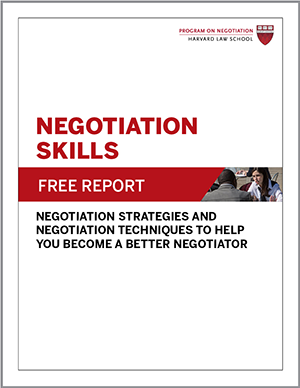
To build your negotiation skills, this three-step approach to managing process issues in negotiation will reap significant rewards:
1. Negotiation Skills: Explicitly Negotiate a Process
Before the negotiation begins, explain what you hope to accomplish and how you propose to go about achieving these goals.
If the other side envisions a different process, you must negotiate how to proceed.
If you prefer a mutual-gains bargaining approach – one that focuses on creating value for everyone involved – you may need to be particularly clear about your intention to spend time up front exchanging information and exploring mutually beneficial options.
Your counterpart may anticipate an entirely different process, such as an exchange of detailed drafts or best offers.
If you don’t clarify these fundamental differences in your approaches to negotiation, the resulting confusion will create mistrust and corrode your results.
Consider how HMO Kaiser Permanente (Oakland, California) reacted during the mid-1990s after relations with a coalition of 26 of its local unions had soured.
To survive in the increasingly competitive healthcare market, Kaiser Permanente knew that it had to change the way it approached negotiations with these unions.
Given the growing mistrust, any unilateral attempt at change would have failed.
Instead, management approached union leaders about jointly designing a new process.
Both sides worked together to design an interest-based negotiation process that began with joint training in mutual-gains techniques.
The resulting partnership is now recognized as one of the most successful interest-based negotiations between labor and management to date.
Finally, in complex negotiations, consider establishing creative processes such as smaller working groups or subcommittees.
2. Negotiation Skills: Build An Agenda
It’s tempting to dive into the substance of the negotiation without first setting an agenda and clarifying some of your purposes.
But while the long-term goals of the negotiation may be clear to all (a signed agreement of some sort), you and your counterpart may have differing assumptions about the results of a particular meeting. You may wish to identify core issues and clarify where each party stands, while the other side hopes to conclude the session with a rough outline of an agreement.
Failure to reconcile these contrasting purposes can lead to unnecessary frustration, with one side appearing to “rush” to agreement and the other side seemingly “wasting time” exchanging information.
For this reason, it pays to spend time up front setting a realistic agenda.
Be sure to set achievable goals for each session, as it’s better to be ahead of schedule than behind.
In addition, when planning your agenda, keep in mind that negotiating teams need opportunities for breaks and caucuses.
Such time-outs allow negotiating teams to ensure that they’re in agreement on various issues and to compare notes about whether the other side seems willing to compromise.
During breaks, adopt a problem-solving mindset.
Time spent complaining about the other side can reinforce negative negotiation dynamics.
3. Negotiation Skills: Manage the Commitment Process
In every negotiation, parties engage in a commitment process. Specifically, they make agreements about the negotiation process – when and how to talk about issues – and the substance, or what decisions to make about these issues.
When making commitments about process, you and your counterparts should focus on the sequencing of issues to be discussed.
Typically, the best sequencing strategy is to begin with easy issues on which you anticipate significant common ground.
When managing substantive commitments, you’ll need to pay attention to packaging. In complex, multi-issue negotiations, some issues are linked and must be dealt with as a package.
In such instances, avoid the temptation to lock in commitments on each issue as you proceed; instead, recognize the need to bundle related issues.
Address issues sequentially (first the easy ones then the hard ones), making tentative agreements on each, until you reach a mutually satisfying and binding agreement on the entire package.
One final note on negotiating the process of upcoming talks.
What should you do when the other side is impatient to dive into the substance of the issues?
In this case, be patient and persistent.
Appeal to the other party’s concern for efficiency by showing him that time spent designing a wise negotiation process will not only save time, but it will also enable wiser, more robust, and more valuable deals.
Do you have a particular process that has improved your negotiation skills? Leave a comment below.
Related Article: The Starbucks-Kraft Dispute – In Business Negotiations, Prepare for Problems
Adapted from “Have You Negotiated How You’ll Negotiate?” by Robert C. Bordone and Gillien S. Todd for the September 2005 issue of the Negotiation newsletter.





